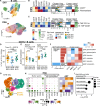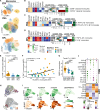Systems analysis unravels a common rural-urban gradient in immunological profile, function, and metabolic dependencies
- PMID: 40305616
- PMCID: PMC12042899
- DOI: 10.1126/sciadv.adu0419
Systems analysis unravels a common rural-urban gradient in immunological profile, function, and metabolic dependencies
Abstract
Urbanization affects environmental exposures and lifestyle, shaping immune system variation and influencing disease susceptibility and vaccine responses. Here, we present systems analysis of immune profiles across the rural-urban gradient, comparing rural and urban Senegalese with urban Dutch individuals. By integrating single-cell phenotyping, metabolic profiling, and functional analysis, we reveal a trajectory of immune remodeling along the gradient. This includes enrichment of proinflammatory CD11c+ B cells associated with altered IgG Fc glycosylation, adaptive NK cells with reduced responsiveness to accessory cytokines, and CD161+CD4+T cells with enhanced cytokine production in rural settings. Metabolic perturbation studies demonstrated distinct dependencies on glycolysis, pentose phosphate pathway, and fatty acid synthesis for cellular cytokine responses across populations. We validate core rural-urban immune signatures in an independent Indonesian cohort, suggesting shared immunological adaptations to urbanization across ancestries and geographical areas. Our findings provide insights into rural-urban immune function in understudied populations.
Figures








References
-
- Smolen K. K., Cai B., Fortuno E. S. R., Gelinas L., Larsen M., Speert D. P., Chamekh M., Cooper P. J., Esser M., Marchant A., Kollmann T. R., Single-cell analysis of innate cytokine responses to pattern recognition receptor stimulation in children across four continents. J. Immunol. 193, 3003–3012 (2014). - PMC - PubMed
-
- de Ruiter K., Jochems S. P., Tahapary D. L., Stam K. A., König M., van Unen V., Laban S., Höllt T., Mbow M., Lelieveldt B. P. F., Koning F., Sartono E., Smit J. W. A., Supali T., Yazdanbakhsh M., Helminth infections drive heterogeneity in human type 2 and regulatory cells. Sci. Transl. Med. 12, eaaw3703 (2020). - PubMed
-
- van Riet E., Adegnika A. A., Retra K., Vieira R., Tielens A. G., Lell B., Issifou S., Hartgers F. C., Rimmelzwaan G. F., Kremsner P. G., Yazdanbakhsh M., Cellular and humoral responses to influenza in gabonese children living in rural and semi-urban areas. J Infect Dis 196, 1671–1678 (2007). - PubMed
MeSH terms
Substances
LinkOut - more resources
Full Text Sources
Medical
Research Materials

